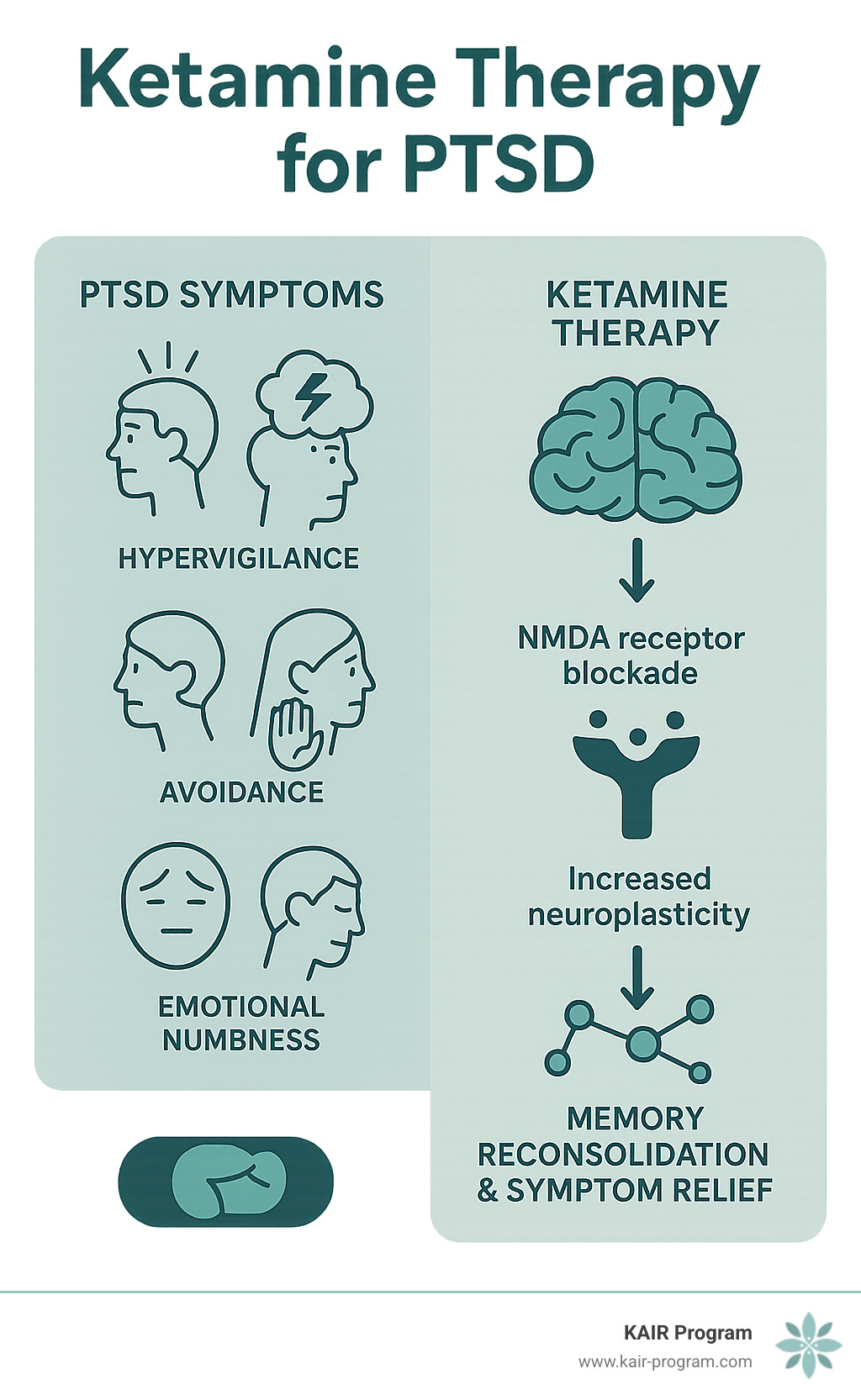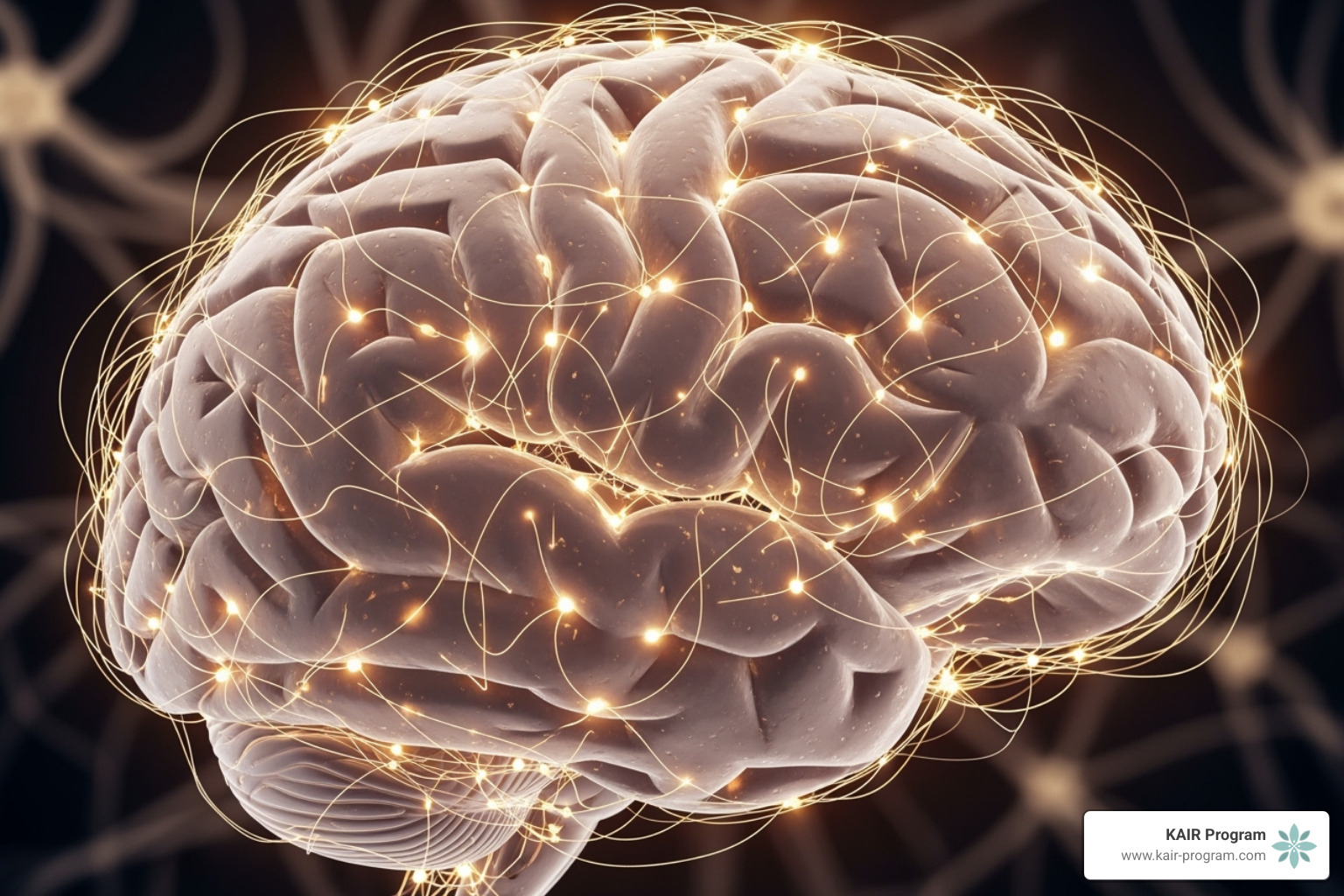Ketamine Therapy and PTSD: Unlocking the Door to Recovery
A New Horizon for Trauma Treatment

Ketamine therapy for trauma is a breakthrough for those who haven't found relief through traditional PTSD treatments. It targets the brain's glutamate system to promote rapid healing and create new neural pathways.
Quick Overview: Ketamine Therapy for Trauma
- What it is: A medically supervised treatment using low-dose ketamine to help process traumatic memories.
- How it works: Blocks NMDA receptors and increases neuroplasticity, allowing the brain to form new, healthier connections.
- Who it helps: People with treatment-resistant PTSD, complex trauma, and co-occurring depression or anxiety.
- Timeline: Effects often begin within hours to days, unlike traditional antidepressants.
- Best results: Achieved when combined with trauma-focused psychotherapy (Ketamine-Assisted Psychotherapy).
For many living with Post-Traumatic Stress Disorder, traditional treatments provide only partial relief. The hypervigilance, emotional numbness, and disconnection from others can persist for years, leaving people feeling hopeless.
Emerging research shows ketamine offers a unique path to healing. By temporarily altering brain chemistry, it creates a window of neuroplasticity where traumatic memories can be processed in new ways.
As Dr. Bambi Rattner, PsyD, I've seen traditional therapy fall short for many trauma survivors. This led me to specialize in intensive methods like EMDR and explore how ketamine can accelerate healing. My experience shows that breakthrough healing often requires breakthrough approaches.

How Ketamine Rewires the Brain to Heal from Trauma
Our brains are remarkably adaptable, and this flexibility, called neuroplasticity, is why ketamine therapy for trauma is so effective.

Ketamine works on the brain's glutamate system. As an NMDA receptor antagonist, it temporarily blocks specific receptors that glutamate, the brain's primary "go" signal, normally activates. This blockade initiates a cascade of healing effects, triggering a surge in Brain-Derived Neurotrophic Factor (BDNF). Often called "brain fertilizer," BDNF promotes synaptogenesis—the growth of new connections between neurons.
This improved neuroplasticity makes the brain more pliable, creating the perfect conditions for healing. It opens a unique window for memory reconsolidation. Traumatic memories often feel frozen, complete with the intense emotions of the original event. Ketamine helps disrupt these rigid fear circuits, allowing you to revisit painful memories with less emotional charge and integrate them into your life story. The scientific research on ketamine's brain effects continues to reveal how profound these changes can be.
The Science of Memory Extinction
Ketamine therapy for trauma also facilitates fear extinction. This isn't about erasing memories, but changing your brain's response to them. Traumatic memories can trigger intense fear even when you're safe, keeping you stuck in the past.
Fear extinction is the brain's natural ability to learn that something previously dangerous is now safe. When you retrieve a traumatic memory under ketamine's influence, it becomes temporarily changeable. This creates a window of opportunity for healing where you can form new, non-traumatic associations. The memory's emotional impact softens, essentially teaching your brain a new way to respond to old triggers. A pilot study on memory extinction shows how promising this approach is for trauma survivors.
From Anesthetic to Antidepressant
Ketamine's journey from the operating room to the therapy room is fascinating. First approved as an anesthetic in 1970, it was used safely in surgical settings for decades. Doctors noticed that patients often reported improved mood after surgery, sparking curiosity about its off-label use for mental health.
Unlike traditional antidepressants like SSRIs, which can take weeks to work, ketamine produces rapid-acting effects, often within hours or days. This speed is a game-changer for trauma survivors in acute distress, providing quick relief that allows them to engage more effectively in therapy.
The Process of Ketamine Therapy for Trauma
Taking the first step toward ketamine therapy for trauma is a guided process designed for your safety and healing.

Your journey begins with a thorough initial consultation to understand your history and goals. This builds trust and helps create a personalized treatment plan. Every session occurs in a comfortable, safe clinical environment with trained professionals monitoring your well-being.
Administration Methods and Dosages
Ketamine can be administered in several ways, depending on your needs:
- Intravenous (IV) infusion: Considered the gold standard for its precise dosage control, the medication is delivered over 40-60 minutes, allowing for real-time adjustments.
- Intramuscular (IM) injection: A single shot that works quickly without the need for an IV line.
- Intranasal spray (esketamine): An FDA-approved form administered under medical supervision in certified clinics.
- Sublingual lozenges: Dissolve under the tongue. While sometimes used for maintenance at home under strict guidance, initial treatments are always supervised.
The doses used are subanesthetic—much lower than for surgery. A typical starting point for IV treatment is 0.5 mg/kg of body weight, but we personalize the dosage based on your response to find the optimal therapeutic benefit.
What to Expect During a Treatment Course
Most people begin with an induction phase of 2-3 treatments per week for several weeks. This helps rapidly reduce acute symptoms and create a state of improved brain flexibility. If the treatment is helping, you may move to a maintenance phase with booster sessions every few weeks or months.
During a session, effects begin within minutes. Side effects typically peak around 40 minutes and may include dissociation or altered perceptions. This state is often therapeutic, allowing you to observe difficult feelings from a distance. These effects are temporary, dissipating within two hours, leaving you feeling grounded and ready to process the experience. The duration of effects from a series of treatments varies, but many report relief for weeks to months.
Ketamine-Assisted Psychotherapy (KAP): The Gold Standard for Trauma
While ketamine alone provides relief, Ketamine-Assisted Psychotherapy (KAP) is the gold standard for trauma healing. Ketamine opens the door to change, but psychotherapy is the guide who helps you steer what's on the other side.

Combining ketamine's neuroplastic effects with structured, trauma-focused therapy creates a powerful foundation for lasting change. During and after the ketamine experience, your brain is highly receptive to deep psychological work. Integration is what transforms temporary relief into sustained healing. A therapist helps you make sense of your experience and weave it into your healing journey.
The Three Phases of KAP
Our approach to ketamine therapy for trauma follows a three-phase structure for safety and effectiveness:
- Preparation Sessions: Before any ketamine is administered, you'll work with your therapist to build trust and set clear intentions. This creates a safe container for the work ahead.
- The Dosing Session: Your therapist remains present as a grounding force while you experience the ketamine. They ensure your safety and offer support, allowing you to have your own experience, whether it's quiet reflection or guided processing.
- Integration Sessions: Following each dosing session, these may be the most crucial part of the process. You'll work to make sense of what emerged, connect insights to your daily life, and translate internal shifts into real, positive changes.
Why Psychotherapy is Crucial for Lasting Change in Ketamine Therapy for Trauma
When ketamine creates a neuroplastic state, it opens a window for new learning. Psychotherapy provides the framework to make the most of this improved brain state. It helps you access and process difficult emotions with less resistance.
Therapy addresses the root causes of trauma, not just the symptoms. It helps you develop healthy coping mechanisms and build resilience for the future. Without this integration work, the benefits of ketamine can be temporary, as old patterns may resurface. Psychotherapy helps prevent relapse by equipping you with practical tools.
At KAIR Program, we've seen how this integrated approach creates lasting change. Our intensive retreats combine the rapid-acting benefits of ketamine with expert-led trauma therapy, creating an environment where deep healing can unfold naturally.
For those interested in learning more about our comprehensive approach, you can find more info about Ketamine Intensive Therapy.
Evaluating the Potential: Benefits, Risks, and Candidacy
Like any powerful treatment, ketamine therapy for trauma requires careful consideration of its benefits, risks, and who it's right for.
Potential Benefits of Ketamine Therapy for Trauma
The potential for trauma survivors is genuinely exciting, especially for those with treatment-resistant conditions.
- Rapid reduction in PTSD symptoms: Intrusive thoughts, flashbacks, and hypervigilance can decrease within hours or days.
- Decreased depression and anxiety: It can lift the heavy fog of co-occurring mood disorders.
- Reduced suicidal ideation: This rapid relief can be life-saving for those in acute distress.
- Improved emotional regulation: Gain more control over emotional responses instead of feeling overwhelmed.
- Improved cognitive flexibility: Break free from rigid, trauma-induced thought patterns.
- Increased openness to therapy: With reduced distress, you can engage more deeply in therapeutic work.
Side Effects and Safety Considerations
In a supervised clinical setting, side effects are temporary and well-managed.
- Dissociation: A common and often therapeutic feeling of detachment from your body or thoughts, which can help in processing difficult memories.
- Mild nausea: Can be managed with preventative medication.
- Temporary increases in blood pressure and heart rate: Monitored closely throughout the session.
- Altered perceptions: Dream-like experiences or shifts in sensory processing.
These effects are short-lived, peaking around 40 minutes and dissipating within two hours. Our medical monitoring throughout the treatment ensures your safety and comfort.
Is Ketamine Therapy for Trauma Right for You?
Determining if this therapy is right for you involves a thorough consultation with our team.
Ideal candidates often include those with:
- Treatment-resistant PTSD who haven't found relief from other therapies.
- Co-occurring depression and anxiety.
- A readiness to engage in psychotherapy for lasting change.
Ketamine therapy may not be suitable for individuals with:
- A history of psychosis (e.g., schizophrenia).
- Uncontrolled high blood pressure or severe heart problems.
- Active substance use disorders.
- Pregnancy or who are breastfeeding.
Our initial consultation is designed to explore all these factors to determine if this path aligns with your healing goals.
The State of the Science: Evidence and Future Directions
The field of ketamine therapy for trauma is growing rapidly, with new research deepening our understanding of this powerful treatment.
Current Evidence and Clinical Trials
Research on ketamine's effectiveness for trauma is building steadily. While first noted for depression, studies now focus directly on its benefits for PTSD and complex trauma.
Meta-analyses combining data from multiple projects show ketamine has a statistically significant effect on PTSD symptoms, with reported standardized effect sizes around 0.25. This represents meaningful improvement for people with treatment-resistant conditions. Research is also distinguishing between short-term and long-term effects, highlighting the crucial role of psychotherapy in sustaining benefits.
Studies focusing on veteran and military populations are helping us understand how ketamine can address the unique challenges of combat-related trauma. For those interested, Ongoing research at Clinicaltrials.gov offers a comprehensive database of current studies.
Limitations and the Path Forward
While promising, we must be honest about where more research is needed. Current studies often have small sample sizes, so larger trials are necessary to confirm findings.
The scientific community is now conducting larger randomized controlled trials (RCTs), the gold standard of research, to better understand who benefits most and under what conditions. Long-term efficacy studies are also needed to determine how to best maintain benefits over time.
There is also work being done to standardize protocols for administration and therapy integration. Finally, more research is needed comparing KAP (Ketamine-Assisted Psychotherapy) with monotherapy to quantify the benefits of an integrated approach, which our clinical experience strongly supports.
Frequently Asked Questions about Ketamine for PTSD
Considering ketamine therapy for trauma brings up many valid questions. Here are answers to the most common concerns.
How quickly does ketamine work for trauma symptoms?
Unlike traditional antidepressants that can take weeks to work, many people notice a rapid reduction in trauma symptoms within hours to days of their first ketamine session. This initial relief provides a crucial head start, but sustained improvement requires repeated sessions and, most importantly, integration through ongoing therapy.
Is ketamine therapy addictive?
When used in a controlled clinical setting, ketamine therapy has a low risk of addiction. The treatment involves medically supervised administration with carefully controlled doses and frequency. The entire focus is on therapeutic use for healing, which is fundamentally different from recreational abuse patterns.
What does a ketamine experience feel like?
The experience is unique to each person, but common themes include:
- A dissociative state: A therapeutic sense of detachment, like observing your thoughts and feelings from a safe distance.
- Altered perceptions of time and space: Time may feel distorted, and you might feel a sense of floating.
- A dream-like state: Insights can emerge naturally, and difficult emotions may feel more manageable.
- Mystical or profound experiences: Some report a sense of connection or sudden clarity.
These experiences vary greatly between individuals. Our team is present throughout to ensure you feel safe and supported.
Conclusion: Opening up a Path to Lasting Recovery
Ketamine therapy for trauma isn't a magic cure, but a powerful tool that can open doors to healing. It rapidly rewires the brain, creating new possibilities through improved neuroplasticity and memory reconsolidation.
What makes ketamine special is the window of opportunity it creates. It temporarily softens the rigid walls trauma builds around painful memories, making them easier to process.
The real magic happens when ketamine meets psychotherapy. While ketamine can quiet the storm of symptoms, it's the integration work with a skilled therapist that transforms temporary relief into lasting change.
At KAIR Program, our ketamine-assisted intensive retreats are built on this truth. We combine the medication with expert-led, trauma-focused therapy, addressing both the brain's biology and the heart's story for those who haven't found relief elsewhere.
If you've been struggling with treatment-resistant PTSD, there is hope. The landscape of trauma treatment is evolving, and ketamine is one of its most promising developments. Recovery is about reclaiming your life.
Ready to learn more about how our integrated approach could support your healing journey? Explore our ketamine-assisted retreats and find what's possible when cutting-edge treatment meets compassionate care.
